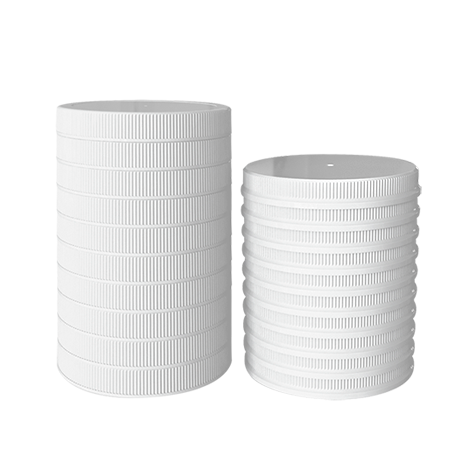Phoenix Case Study:
How Stacking Caps Can Reduce Greenhouse Gas Emissions
It might be hard to imagine how stacking a plastic cap could benefit the environment. PHOENIX used some out-of-the-box thinking to reduce our greenhouse gas emissions through reducing pack count, shipping lighter loads and redesigning caps to optimize the use of material.
The Benefit of Stacking
Large diameter caps, such as a 120mm closure, uses a lot of space in a box when packed traditionally. When a large cap is stacked it allows more caps per carton by reducing the amount of space between each cap. For comparison, imagine the measuring cups in your kitchen cabinet. Cups that can nest neatly inside one another take up less space, than a dozen cups tossed randomly into a cupboard. The positive impact of a stacked cap compounds when shipping and handling is considered. Allowing more caps in a carton requires fewer trucks on the road to get product shipped from point A to point B. When PHOENIX redesigned a 120mm closure in 2019, the pack count increased from 175 to 328 for an impressive 87% increase.
How Stacking and Weight Reduction Work Together
With the redesign to create a nested cap, PHOENIX’s Engineering Team also had an opportunity to evaluate the amount of material used to create the cap in the manufacturing facility. Through an FEA analysis[1] that projected the cap’s rigidity, it was determined that the new reduction in resin could reduce the cap weight by almost 19% and still maintain PHOENIX’s extremely high-quality standards.[2] [3]
Changes Made in the Manufacturing Process
Considerable reevaluation of PHOENIX’s existing equipment was conducted by our Process Engineers, Tooling Engineers, and Manufacturing Project Engineers in addition to our equipment suppliers during every stage of this redesign project. While a more basic redesign project may require changes to one or two components within the manufacturing line, a larger scope redesign, such as this stacked cap, gave PHOENIX an opportunity to optimize the entire manufacturing cell. New molding machines equipped with state-of-the-art vision systems to monitor quality were paired with a stacking and carton loading stations. The significant capital investment PHOENIX made toward this redesign project is a testament to our commitment toward doing the right thing for the environment and our customers.
The Creation of EcoStack®
FEA Analysis not only projects the cap’s rigidity accurately, but also the durability and functionality. PHOENIX engineers can use algorithms to calculate how a force exerted on one spot of the cap will cause the rest of the cap to bend or twist. They can also simulate the pressure and force exerted on the closure during production, filling, shipping, and consumer use. If performance is not up to par, adjustments to the design are made to address any points of failure.
However, nothing is approved for production until a prototype is created. Prototypes are created in an injection mold and then subjected to several physical tests such as drop tests, liner tests, leak tests and torque tests. Large samples of molded parts are measured to verify performance. Prototype creation also allows PHOENIX to examine how the new design performs on a customer’s production line as well. Because capping equipment is carefully calibrated and sensitive to small changes, our customer’s feedback on how the cap performs is essential before moving into full production.
After these rigorous tests, PHOENIX expectations were exceeded. The EcoStack® 120mm closure was created and put into commercial production. Several months later, PHOENIX introduced the 110mm EcoStack® closure to our product line.
Benefiting the Environment
The 120mm EcoStack has already made a significant impact on PHOENIX’s environmental footprint. Since its introduction in 2017 PHOENIX estimates that shipping the newly designed closure reduced the number of trucks on the road by more than 100.[4] In addition, the weight reduction of PHOENIX’s largest diameter cap has saved more than 159 metric tons of resin since 2017. That is enough plastic to fill 38,900 gallon milk jugs!
The Future of EcoStack®
Continuing to make improvements on our processes and procedures is a pinnacle goal at PHOENIX. Due to customer demand, our engineering department is working on redesigning smaller sized closures into the EcoStack® design concept.
Sources:
[1] Finite Element Analysis, a computerized method for predicting how a product reacts to real-world forces, vibration, heat, fluid flow and other physical effects.
[2] For a more in-depth case study on light weighting closures, please see PHOENIX’s case study
[3] Calculation based on gram weight difference of 120-400-9613 and 120-400-9639
[4] Based on sales data from January 2017 through September 2022


